Samsung Galaxy S III Performance Preview: It's Fast
by Brian Klug & Anand Lal Shimpi on May 3, 2012 6:13 PM EST- Posted in
- Smartphones
- Samsung
- Mobile
- SoCs
- Exynos 4 Quad
- Galaxy S III
Earlier today Samsung unveiled its Galaxy S III, at the heart of which is Samsung's new Exynos 4 Quad SoC. Fortunately we got a ton of hands on time with the device at Samsung's unpacked event in London and are able to bring you a full performance preview of the new flagship, due to be shipping in Europe on May 29th.
The Exynos 4 Quad is an obvious evolution of the dual-core Exynos in many of the Galaxy S II devices. Built on Samsung's 32nm high-k + metal gate LP process, the new Exynos integrates four ARM Cortex A9s running at up to 1.4GHz (200MHz minimum clock). Each core can be power gated individually to prevent the extra cores from being a power burden in normal usage. Each core also operates on its own voltage and frequency plane, taking a page from Qualcomm's philosophies on clocking. There is no fifth companion core, but the assumption is Samsung's 32nm HK+MG LP process should have good enough leakage characteristics to reduce the need for such a design.
The GPU is still ARM's Mali-400/MP4, however we're not sure of its clocks. Similar to the dual-core Exynos, there's a dual-channel LPDDR2 memory controller that feeds the entire SoC. The combination should result in performance competitive with NVIDIA's Tegra 3 (and a bit higher in memory bandwidth limited scenarios), but potentially at lower power levels thanks to Samsung's 32nm process.
While we won't know much about the power side of things until we get a review device in hand, we can look at its performance today.
Browser & CPU Performance: Very Good
As always, we start with our Javascript performance tests that measure a combination of the hardware's performance in addition to the software on the device itself. Sunspider performance is extremely good:
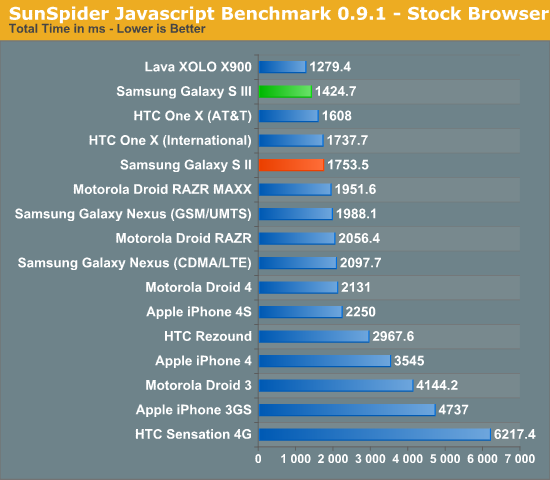
While we thought we hit a performance wall around 1800ms, the One X from HTC, the Lava XOLO and now the Samsung Galaxy S III have reset the barrier for us. In this case the performance boost is likely more due to software than hardware, but the combination of the two results in performance that's better than almost anything we've seen thus far. The obvious exception being Intel's Medfield in the X900.
BrowserMark is another solid js benchmark, but here we're really able to see just how much tuning Samsung has done in its browser:
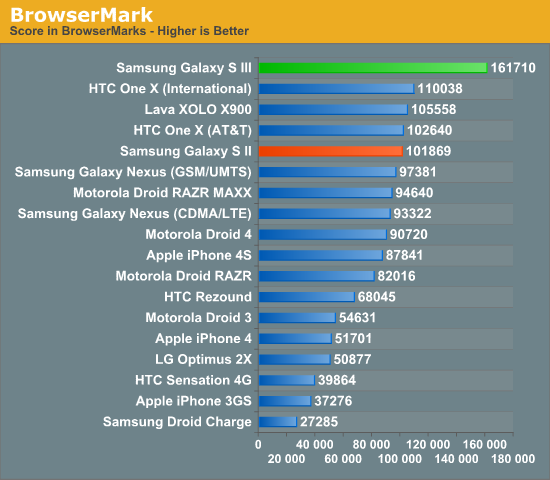
The Galaxy S III is significantly faster than anything else we've ever tested thus far. The browsing experience in general is very good on the SGS3, and the advantage here likely has more to do with Samsung's browser code and the fact that it's running Android 4.0.4 rather than any inherent SoC advantage. We know how 1.4GHz Cortex A9s should perform, and this is clearly much better than that.
Once again we turn to Qualcomm's Vellamo to get an idea for browser and UI scrolling performance:

Although (understandably) not as quick as the Snapdragon S4 based One X, the SGS3 does extremely well here - likely due in no small part to whatever browser optimizations ship in Samsung's 4.0.4 build. As Brian put it when he first got time with the device: it's butter.
GPU Performance: Insanely Fast
While we don't know the clocks of the Mali-400/MP4 GPU in the SGS3, it's obviously significantly quicker than its predecessor. Similar to what we saw when the Galaxy S II launched, Samsung once again takes the crown for fastest smartphone GPU in our performance tests.
The onscreen GLBenchmark Egypt and Pro results are understandably v-sync limited, but if you look at how much headroom is available thanks to the faster GPU it's clear that the Galaxy S III should be able to handle newer, more complex games, better than its predecessor.
What's particularly insane is that Samsung is able to deliver better performance than the iPhone 4S, the previous king-of-the-GPU-hill in these tests.
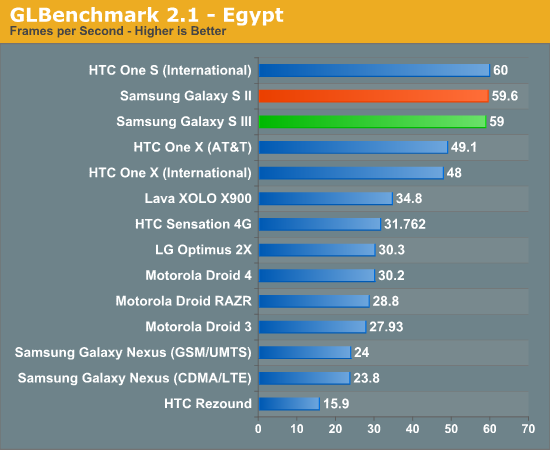
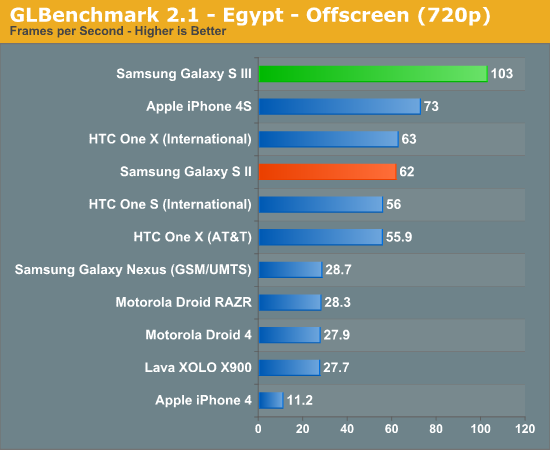
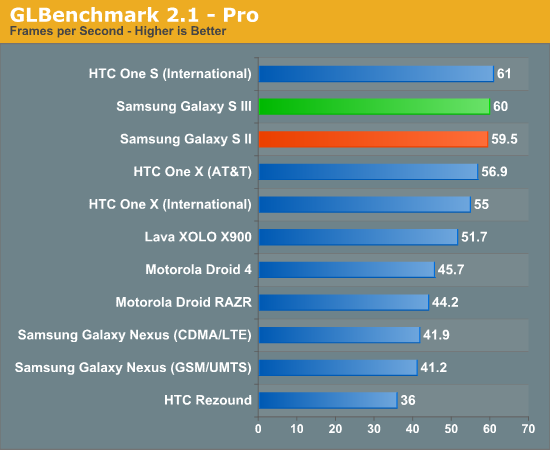
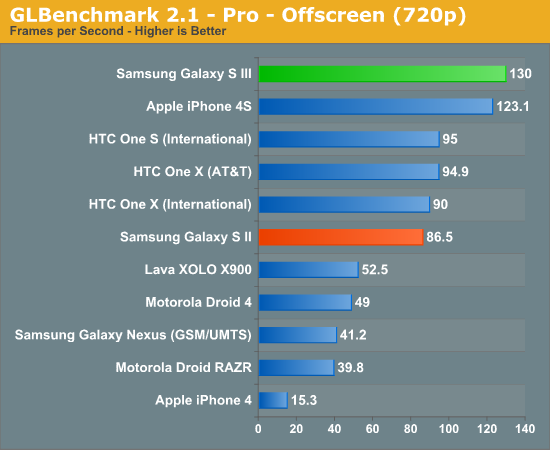
The performance advantage isn't anywhere near as staggering if we look as BaseMark ES 2.0, however as we've mentioned before this benchmark is definitely showing its age at this point. Despite the aggressive tuning Qualcomm has done for these benchmarks, Samsung is actually able to remain competitive and even pull out a slight win in the Taiji test. Both benchmarks are v-sync limited on the fastest platforms however.
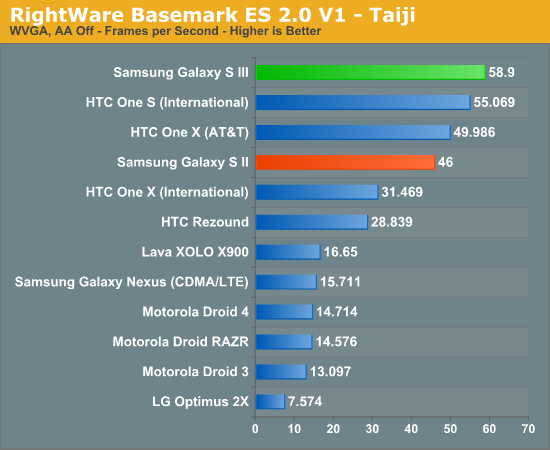
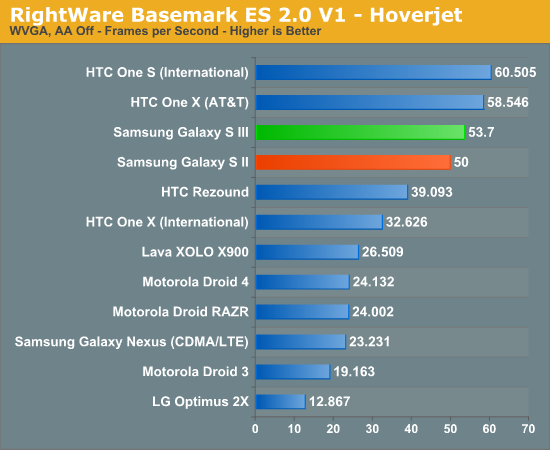
Final Words
Our first interactions with Samsung's Exynos 4 Quad are promising, but there's still much more to understand. Samsung clearly used 32nm as a means to higher GPU clock speeds, which in turn gives us much better GPU performance. The big unknown, as always, is power consumption. Based on what we've seen thus far from Samsung's 32nm LP process in Apple's iPad 2,4 (review forthcoming), Exynos 4 Quad should be a pretty good step forward in the power department as well.
As soon as we can get our hands on final hardware you can expect a full review of the Galaxy S III, including power and battery life analysis.
Initial reactions to the Galaxy S III announcement seemed almost disappointing, however stay tuned for our hands on impressions of the device as well as even more depth/detail on the hardware platform - you may be surprised.















92 Comments
View All Comments
tipoo - Friday, May 4, 2012 - link
*Which is not to say javascript doesn't see increases on multicore. It does, but it doesn't seem to go beyond two.Aenean144 - Friday, May 4, 2012 - link
There's little evidence that the benchmark even goes beyond one thread. If it does, it's not much of a gain at all going from one to two cores.Aenean144 - Friday, May 4, 2012 - link
iOS has an excellent javascript JIT.Skiddywinks - Thursday, May 3, 2012 - link
Well, that's settled it; I'll be phoning Orange tomorrow and making sure I get one of these day one, since my contract is already up and I am on a rolling month-to-month contract atm.Glad I waited, and didn't go for the One X (EU).
steven75 - Sunday, May 6, 2012 - link
Not sure why... One X performance is similar, looks WAY better, has by far a superior display, and has less junky software added which theoretically means faster updates compared to Samsung who already has a history for poor update support.staticx57 - Thursday, May 3, 2012 - link
My Galaxy Nexus with a mild overclock and custom Rom/Kernal gets a browsermark score of 120k versus the GS3 score of 160k. I can only imagine what the GS3 will manage to accomplish once the phone is truly unleashed.RussianSensation - Thursday, May 3, 2012 - link
You seriously overclocked your cell phone? hehhe. Dang, you want some LN2 with that?tipoo - Thursday, May 3, 2012 - link
So did I, and lots of other people...In most custom ROMs its just a few button clicks away, not that big a deal.tipoo - Thursday, May 3, 2012 - link
Just thinking here, the only other quad A9 (Tegra 3) has a single channel memory controller feeding it, maybe there's more that could have been done with the A9s which is what we're seeing here.Braumin - Thursday, May 3, 2012 - link
OK, so Browsermark looks good, but is Samsung tuning thier browser to do these types of benchmarks faster? It is not unheard of - nVidia and AMD both have done it for certain benchmarks. On a phone, the cross platform benchmarks are pretty limited so it wouldn't take much to code for the few that are out there.What does a good browsermark score equate into page load times? Hopefully you guys can cover this in the review.